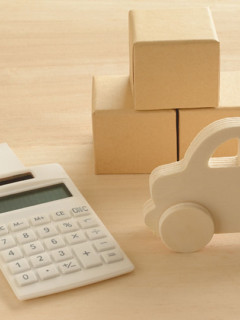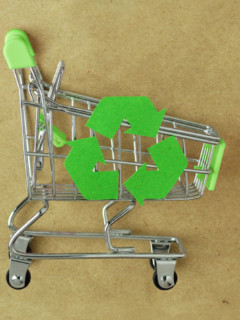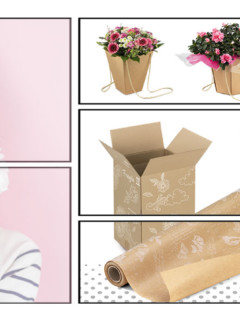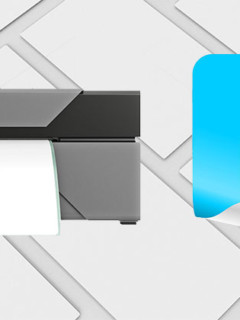Packaging aids play a crucial role in logistics, the mail order business and warehousing. They ensure secure packaging, protection of the goods and efficient handling. But what packaging aids are there, what should you look out for and what advantages do they offer? In this article, we answer the most frequently asked questions about packaging aids.
What are packing aids?
Packaging aids are all materials that are used to secure, reinforce or label packaging. They support the packaging process by improving the protection of the goods and enabling easier handling. Without packaging aids, it would hardly be possible to ship goods safely, especially in sectors such as e-commerce, industry and stationary retail.
| Category | Examples |
|---|---|
| Packaging material | Paper, plastic film, corrugated cardboard |
| Packaging material | Carton, bag, bottle, can |
| Packaging aids | Adhesive tape, strapping tape, filling material, label, stretch film |
Differentiation from packaging material and packaging material
In packaging technology, there is a clear distinction between packaging aids, packaging materials and packaging substances:
- Packagingmaterials are the basic materials from which packaging is made, such as paper, plastic, cardboard, corrugated cardboard, glass or metal.
- Packaging materials are the actual containers in which goods are packaged, such as cartons, tins, bags or bottles.
- Packaging aids are supplements to the packaging materials that improve their functionality, such as adhesive tape, strapping tapes, filling materials or labels.
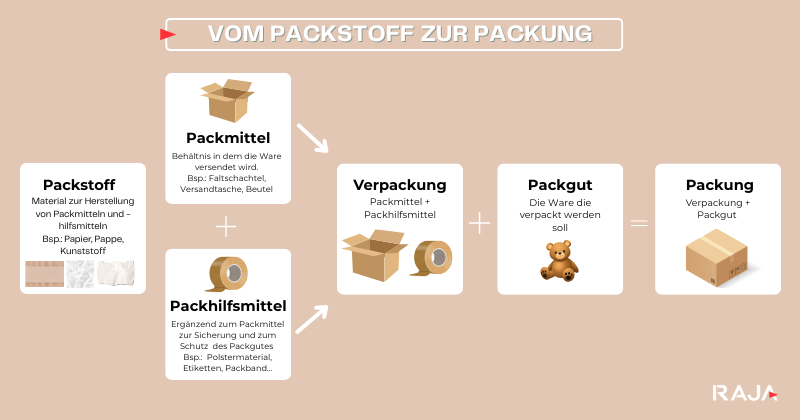
Packaging aids according to DIN 55405
DIN 55405 defines packaging aids as “aids that are used to close, protect, stabilise, secure, identify or prepare packaging materials or packages for transport and storage.” This standard ensures standardised terminology in the packaging industry and helps companies to select the right packaging aids for their specific requirements.
What types of packaging aids are there?
Packaging aids can be divided into four main categories according to their function:
-
Cohesion of packaging materials
-
- Stretch filmFor wrapping pallets and stabilising goods to prevent them from slipping.
- Strapping bandsFor securing heavy or large packages, usually made of plastic or steel.
Stretching pallets with stretch film
Correct palletising – pallet packing made easy
The right strapping – everything you need to know about sealing techniques, materials and machines used
-
Sealing packaging
-
- Adhesive tapeFor the secure sealing of cartons and parcels. Variants are paper adhesive tape, PP adhesive tape or wet adhesive tape for heavy cardboard packaging.
- Security seals (seals): Prevent unauthorised opening of packaging.
Types of adhesive tape – Which adhesive tape do I use for what?
Adhesive tape on different surfaces: What do you need to look out for?
How does adhesive tape work? The science behind adhesion and holding power
-
Additional protection for packaged goods
-
- Filling material: Protection of sensitive products with bubble wrap, paper or foam chips.
- Desiccants: Protect goods such as electronics or metals from moisture and corrosion.
- Moisture indicators: Monitor the humidity inside the packaging to prevent damage.
- Corrosion protection and oil paper: Prevents corrosion of metal parts and machine components caused by moisture or oil residues.
We have described how moisture can be prevented during shipping with the help of packaging aids in the article on moisture protection in parcels.
Production of bubble wrap and its properties
Moisture protection in a parcel
Rust-proof packaging with VCI corrosion protection packaging
-
Information and labelling
-
- Labels and markings: Used to label and quickly identify consignments, these include delivery note pockets for important documents or warnings such as “Caution glass” or “Do not stack”.
Packaging symbols and their explanation
Labelling parcels for DHL, Hermes, UPS
Why are packing aids important?
Packaging aids help to ensure that goods arrive safely at their destination. They protect against damage, moisture, impact and slippage. They also facilitate warehousing and handling in logistics. The quality of packaging is a decisive factor in online retail in particular, as it also has an impact on customer satisfaction. A securely packaged product reduces returns and ensures a professional perception.
How do you choose the right packaging aids?
The choice of the right packaging aids depends on various factors:
- Type of goods: Fragile or sensitive products require more protection. This includes, for example, a combination of filling material and sturdy cardboard packaging.
- Transport route: Long transport routes require more stable packaging. An international delivery often requires additional protection in the form of strapping or reinforced cardboard packaging.
- Weight of the consignment: heavier products require stronger cardboard boxes and more secure closures to prevent damage.
- Sustainability: Environmentally friendly packaging aids reduce the ecological footprint. Companies that value sustainable packaging opt for recyclable or biodegradable materials.
What sustainable alternatives are there?
More and more companies are focussing on environmentally friendly packaging aids, including:
- Paper tape instead of plastic adhesive tape. This is fully recyclable and saves plastic waste.
- Recycled and reusable cardboard packaging to reduce waste. Many cardboard boxes are already made from recycled material and can be used several times.
- Biodegradable filling material as an alternative to plastic or polystyrene. Corn starch chips or paper padding offer the same protection as conventional materials, but are more environmentally friendly.
- Reusable packaging for sustainable logistics processes. Reusable boxes are a cost-saving and environmentally friendly alternative, especially in industry or in the B2B sector.
Tips for the optimal use of packaging aids
- Pack efficiently: Make the best use of available space to avoid wasting material.
- Close securely: Apply adhesive tape correctly to prevent the packaging from being opened.
- Use labelling: Labels such as “Fragile” or “Top” help to prevent damage in transit.
- Pay attention to the environment: When buying packaging aids, opt for recyclable or sustainable products.
Packaging aids are indispensable
Packaging aids are essential for the safe shipping and storage of goods. Choosing the right materials can improve product protection, facilitate handling and even contribute to sustainability. Investing in high-quality packaging aids saves time and money in the long term and ensures satisfied customers. Companies should not only pay attention to efficiency, but also to environmental compatibility in order to create sustainable shipping solutions. In addition to the “classics” such as adhesive tape and padding material, we would like to conclude with a few interesting aids and accessories for your packaging processes:
The palletising stick (also known as the palletising mouse), for example, makes strapping your pallets much easier, and you are guaranteed to find the right aid for your packing processes among the stretch film dispensers and in our edge protection and corner protection category.











